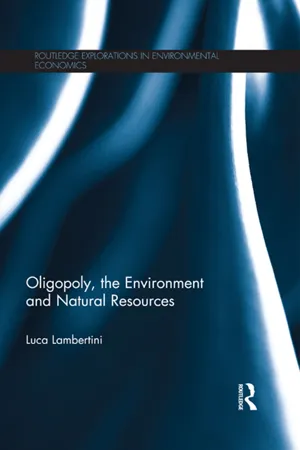
- 342 pages
- English
- ePUB (mobile friendly)
- Available on iOS & Android
Oligopoly, the Environment and Natural Resources
About this book
Industrial production and consumption patterns rely heavily on the intensive use of both renewable and non-renewable resources and the consequences for the environment can be serious. Following a long period of time where the profit incentives of firms have prevailed over preservation of the environment and the world's natural resources, a new consensus has emerged concerning the need to regulate firm behaviour, aimed at ensuring the sustainability of the economic system in the long run.
This book offers an exhaustive overview of current economic debate about these topics, taking modern oligopoly theory as a benchmark. The first part of the book covers static models dealing with incentives for green research and development, Pigovian taxation, cartels, environmental quality and international trade, as well as the role of corporate social responsibility, public firms and consumer environmental awareness as endogenous regulatory instruments.
Then, the author moves on to examine the role of time while drawing from optimal control and differential game theory. This opens the way to the discussion of fair discount rates to ensure the welfare of future generations, as well as the long run sustainability of production and consumption patterns.
Frequently asked questions
- Essential is ideal for learners and professionals who enjoy exploring a wide range of subjects. Access the Essential Library with 800,000+ trusted titles and best-sellers across business, personal growth, and the humanities. Includes unlimited reading time and Standard Read Aloud voice.
- Complete: Perfect for advanced learners and researchers needing full, unrestricted access. Unlock 1.4M+ books across hundreds of subjects, including academic and specialized titles. The Complete Plan also includes advanced features like Premium Read Aloud and Research Assistant.
Please note we cannot support devices running on iOS 13 and Android 7 or earlier. Learn more about using the app.
Information
| Resource | Te |
Oil | 20 |
Natural gas | 22 |
Coal | 111 |
Iron | 93 |
Copper | 21 |
| Lead | 21 |
| Resource | Te |
Oil | 42 |
Natural gas | 60 |
Coal | 133 |
Iron | 72 |
Copper | 35 |
Lead | 22 |
Table of contents
- Cover
- Half Title
- Title Page
- Copyright Page
- Dedication
- Table of Contents
- List of figures
- List of tables
- Preface
- Acknowledgements
- 1. Introduction: a tragedy of commons
- 2. Oligopoly, Pigouvian taxation and pollution permits
- 3. Mergers, vertical relations and collusion
- 4. Environmental quality, quality standards and the Porter hypothesis
- 5. Mixed oligopoly and corporate social responsibility
- 6. Consumer environmental awareness
- 7. International trade
- 8. Dynamic games I: the environment
- 9. Dynamic games II: natural resources
- Appendix: elements of optimal control and differential game theory
- Notes
- References
- Index